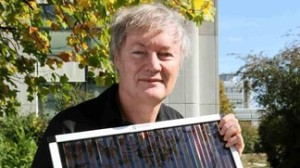May 16 2014
Despite their solar-energy conversion efficiency, hybrid lead halide perovskites have high costs of manufacturing because of the expensive materials used for hole-transporting. By using a cheap inorganic alternative, EPFL scientists have achieved 12.4% power-conversion efficiency.
Hybrid organic–inorganic methylammonium lead halide perovskites have attracted intense attention for thin-film photovoltaics, due to their large absorption coefficient, high charge carrier mobility and diffusion length. However, the organic materials used for hole-transportation are costly because of their manufacturing demands complicated synthetic procedures and high purity. Publishing in Nature Communications, scientists from EPFL have achieved 12.4% conversion efficiency using a cheap, inorganic hole-transporting material on lead halide perovskite-based devices.
 © 2014 EPFL
© 2014 EPFL
The new version of the Grätzel cells uses a perovskite as a light harvester overlain with a hole-transport material, which is responsible for the movement of electrons across the system. In the past two years, hybrid organic-inorganic hole transporters have been used on perovskite cells up to an efficiency above 15%. However, the cost of manufacturing is prohibitive.
The team of Michael Grätzel at EPFL has successfully used an alternative, considerably cheaper material as a hole transporter on lead halide perovskite devices. Under full solar illumination, they have achieved a 12.4% efficiency. The success opens the way for cost-effective, energy-efficient perovskite solar cells.
Reference
Qin P, Tanaka S, Ito S, Tetreault N, Manabe K, Nishino H, Nazeeruddin MK, Grätzel M. (2014) Inorganic hole conductor-based lead halide perovskite solar cells with 12.4% conversion efficiency. Nature Communications 5, 3834 DOI:10.1038/ncomms4834
Author: Nik Papageorgiou
Source: Campus durable